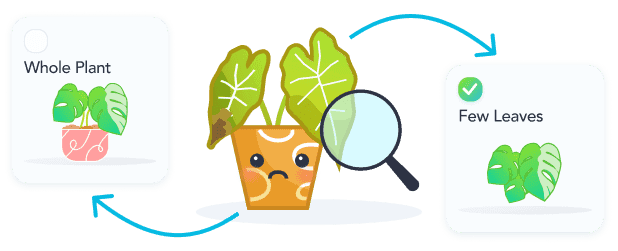Every 7d
Recommended Frequency
1 /2 cup of water
Recommended Amount
The Peacock plant prefers to stay moist but not water logged. Water your plant when the top one to two inches feels dry. Careful not to overwater as this will cause root rot.
Every 30d
Recommended Frequency
Fertilize your Peacock Plant once a month during autumn, winter, and spring using a 15-15-15 fertilizer diluted by half.
Medium Light
Recommended
Medium light is achieved when your plant is able to receive indirect light while sitting about 5 feet away from a south or west-facing window. The lighting from this distance should be adequate for your plants that requi...
Every 730d
Recommended Frequency
Repot your Peacock Plant every two years, or once it outgrows its pot.
For the peacock plant, maintaining an ideal temperature range is crucial for its health and vibrancy. The recommended temperature range for this plant is between 75 to 85 degrees Fahrenheit. This range suggests that the ...
Peat Soil
Recommended Soil
Peat Soil is an acidic soil that retains a lot of moisture and slows decomposition. Due to such a high moisture retention this mix may require irrigation to help with draining. This soil type is best used when paired wit...

Shop Peacock Plant
Questions about Peacock Plant
A Peacock Plant, scientifically known as Calathea makoyana, is a tropical houseplant celebrated for its striking, ornately patterned leaves that resemble a peacock's tail. Native to the Brazilian rainforest, it thrives i...

Toxicity of Peacock Plant

Common Pests and Diseases
Root Rot
Overwatering
To address root rot in peacock plants, first, stop watering immediately and allow the soil to dry out. If the plant is severely affected, remove it from its pot, trim away any black, mushy roots, and repot in fresh, well-draining soil. Ensure the pot has adequate drainage holes. Going forward, water only when the top inch of soil feels dry to the touch and consider using a pot with better drainage to prevent future occurrences.
Leaf curling and browning
Underwatering
To address leaf curling and browning caused by underwatering, it's crucial to establish a consistent watering schedule that keeps the soil evenly moist but not waterlogged. Check the soil moisture by inserting your finger about an inch deep; if it feels dry, it's time to water. Use lukewarm water to avoid shocking the plant's roots. Additionally, consider increasing humidity around the plant through misting or using a pebble tray with water, as Peacock plants thrive in higher humidity environments.
Spider Mites
Spider mites are tiny pests that thrive in warm, dry conditions. They feed on the sap of the peacock plant, causing yellowing, speckled leaves, and webbing on the plant.
To combat spider mites, increase humidity around your peacock plant, as these pests prefer dry conditions. Regularly misting the plant can help. Additionally, washing the leaves with a gentle stream of water or using an insecticidal soap can remove and prevent further infestation. For severe cases, applying neem oil or a miticide specifically designed for spider mites can be effective. Always isolate infested plants to prevent the spread to other houseplants.
Leaf curling
Low humidity
Peacock plants thrive in high humidity environments, often requiring levels of 60% or higher. To address leaf curling caused by low humidity, consider placing your plant on a humidity tray filled with water and pebbles, ensuring the pot sits on the pebbles and not in the water. Alternatively, use a room humidifier to increase the ambient humidity. Regular misting can also help, but ensure to mist in the morning so the leaves have time to dry during the day.

Related Plants
Other Articles:
Top 10 Most Popular Roses
Mar 22, 2022
How to Care for China Roses
Mar 11, 2022
How to Care for Chinese Money Plants
May 15, 2020
How to Grow and Care for A Bird of Paradise
Apr 26, 2020
Top 10 Plants To Grow In A Terrarium
May 31, 2022
How to Grow and Care for Lucky Bamboo
Mar 29, 2022
How to Grow and Care for Corn Plants
Mar 29, 2022
How to Care for Madagascar Dragon Trees
Mar 21, 2022



